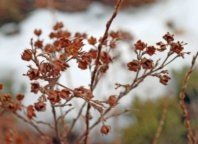 Did you know that 8 of first measurable snowfalls in Denver during the last 10 years took place in October? And we’ve already passed all but one of the November first-snow dates. Lack of moisture isn’t just a Front Range scenario, either. In the high country resorts continue to push back start dates for the ski season due to lack of snow.
Did you know that 8 of first measurable snowfalls in Denver during the last 10 years took place in October? And we’ve already passed all but one of the November first-snow dates. Lack of moisture isn’t just a Front Range scenario, either. In the high country resorts continue to push back start dates for the ski season due to lack of snow.
We had only about 1/4″ of precipitation in October followed by zip in November. We are short on moisture. And even if we get a few inches of snow in the near future, the amount of water won’t be sufficient to quench the thirst of a drying root zone. Typically, it takes 10 to 12 inches of snow to equal only 1 inch of rainfall.
Root zones need to be in ideal conditions heading into the winter. Plant health does start from the ground up and it’s not healthy for roots to dry out. And the same goes for bulbs that are working underground throughout the dormant season so they can push up those early spring blooms.
Plants need water and when Mother Nature doesn’t provide, it’s up to us to be good stewards of our ecosystem and fill the gap. Here are watering reminders to maintain adequate soil moisture during fall and winter:
- Remember watering season doesn’t always end when the sprinkler system is winterized. Do the screwdriver test on the lawn and if the soil is dry, pull out the hose and sprinkler to water dry areas manually.
- South-facing and sloped areas dry out first. Make them the priority for fall and winter watering. Since dry lawns are where turf mites thrive, keeping soil moist will deter these pests as well.
- If you are watering the lawn, trees in the lawn will receive some moisture. But trees in bed areas also need water. Best practice is to use a deep-root watering device that attaches to a garden hose. Probe the soil at intervals around the drip line of the tree so that water is pushed deep into the root zone. The drip line is the circle you would draw on the ground that corresponds to the outside reach of the tree’s branches. This method is also advisable for trees in lawn areas.
- The root systems of all newly planted lawns, trees, shrubs and perennials are much less developed than those of mature plants. New plants will need extra monitoring and moisture so they prepared to enter the winter.
As long as the ground is not frozen, soil moisture should be checked and plants watered as needed. This is how we show our plants we love them over the winter.
